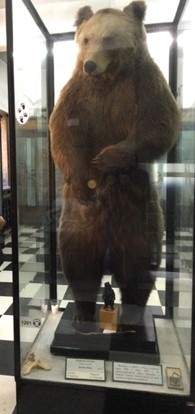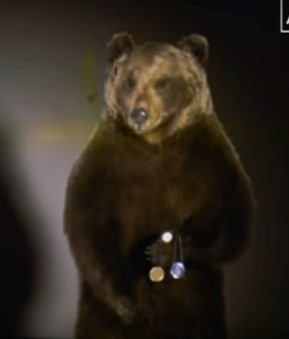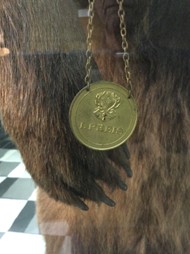Written by Richard Crawford, who has just completed a PhD thesis at the University of the Arts London, entitled ‘Re-presenting taxidermy; Contemporary Art interventions in Natural History Museums’.
I am used to seeing trophy specimens in mainstream natural history museum collections – for example, the crouching tiger shot by King George V in 1911 that is on display in the natural history galleries at the Royal Albert Museum in Exeter – but I was surprised to see a taxidermy specimen of a big Brown Bear at the National Museum of Natural History, Sofia, holding a medal that it had been awarded at the Berlin International Hunting Exhibition in 1937.

The 1937 Berlin International Hunting Exhibition showcased all manner of hunting trophies including mounted antlers, boar heads, bear skins and various taxidermy animals. It also featured demonstrations with live animals, including hunting eagles and a pack of beagles. The event was given official approval by the then prime minister, Hermann Goering, who opened the exhibition amid fluttering Nazi flags and rows of hunters dressed in smart grey uniforms. In his opening remarks, Goering stated his view, that hunting could promote international peace:
“I greet the hunters of the world on the occasion of the international hunting exhibition 1937 in the capital of the German empire. I wish and hope that this great gathering of all well-suited hunters in special mass may help to promote the understanding of the peoples among themselves and to serve the peace of the world”.[1]
Those well-suited hunters look suspiciously like solders, lined up in rows under the Nazi flags – hardly a good look for peace ambassadors.
In a contemporary film made of the opening ceremony for the German television news[2], the brown bear is featured with 3 medals dangling from its paw, only one of which is now features in the display. This medal bears a swastika and the inscription ‘1 PREIS’. Another medal bearing an antler motif is displayed on the floor of the case, by the bear’s feet.


Each nation participating in the exhibition (there were 25 including the UK[1]) was given its own area in the exhibition halls. The prizes that were handed out were donated by high-ranking Nazi officials – who included Goering and Hitler. This particular medal was probably awarded to the big brown bear because it was judged to be the best exhibit in the Bulgarian section of the exhibition.
There was a hand written label in the case, but because I was unable to read the Cyrillic text, I had to ask one of the museum’s interpretation officers who spoke English, about this taxidermy display. She told me how the bear how had won its medal and added that it had become a sort of mascot for the museum (rather like the Horniman Walrus?). I learned more about the bear’s biography by searching for information on the internet subsequent to my visit. I find these historical details fascinating because by providing a context to the museum display, they help me to understand the material biography of the taxidermy bear.
References
[1] https://www.forestryofthethirdreich.eu/internationale-jagdausstellung-1937
[2] https://werkleitz.de/en/internationale-jagdausstellung-in-berlin-1937/
[3] Egypt, Africa, America, Asia, Belgium, Bulgaria, Denmark, Gdansk, Estonia, Finland, France, UK, Netherlands, Italy, Japan, Yugoslavia, Canada, Latvia, Luxembourg, Norway, Austria, Poland, Portugal, Romania, Sweden.




